Analysis of Education Disparity in Malaysia: A Report
VerifiedAdded on 2023/01/19
|10
|2930
|56
Report
AI Summary
This report delves into the issue of education disparity in Malaysia, highlighting the significant differences between urban and rural schools. It explores how these disparities impact the nation's economic growth, examining the roles of primary, secondary, and preschool education. The report discusses the challenges stemming from weak governmental policies, economic structures, and the management of the education system, particularly in rural areas. It analyzes factors such as infrastructure deficiencies, teacher qualifications, and the provision of basic necessities. The report also covers enrollment trends, the structure of the Malaysian education system, and various subjects taught. It addresses the influence of ethnic boundaries, geographical challenges, and the government's efforts to reduce inequality. Furthermore, it examines the impact of inequality on students with disabilities and the importance of addressing prejudice within the education system, advocating for steps to ensure equal opportunities and improve the education system for all Malaysians. This report is a valuable resource for understanding the complexities of education disparity and its implications for Malaysia's future.
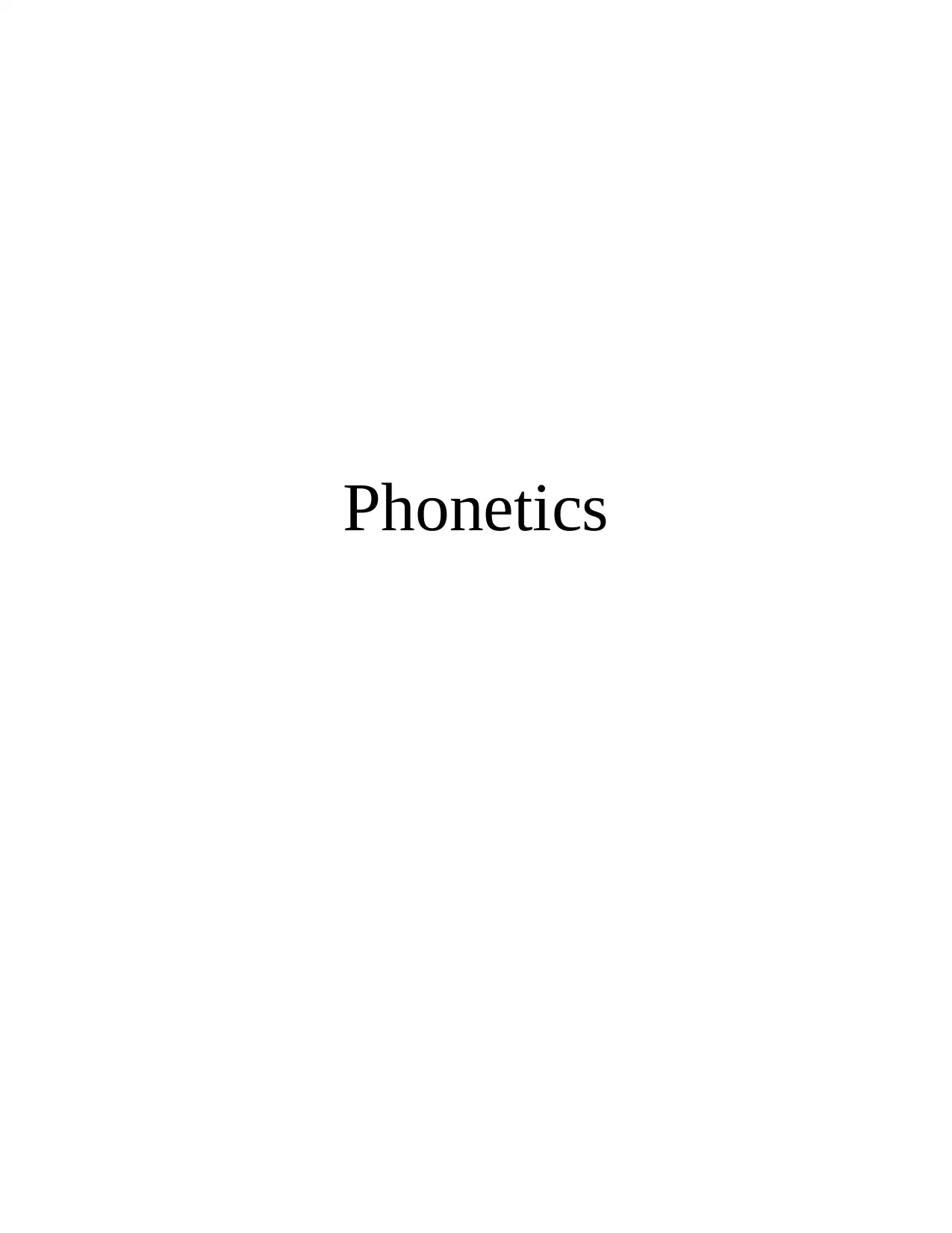
Phonetics
Paraphrase This Document
Need a fresh take? Get an instant paraphrase of this document with our AI Paraphraser

Table of Contents
TITLE .............................................................................................................................................1
INTRODUCTION ..........................................................................................................................1
CONCLUSION................................................................................................................................6
REFERENCERS .............................................................................................................................7
TITLE .............................................................................................................................................1
INTRODUCTION ..........................................................................................................................1
CONCLUSION................................................................................................................................6
REFERENCERS .............................................................................................................................7
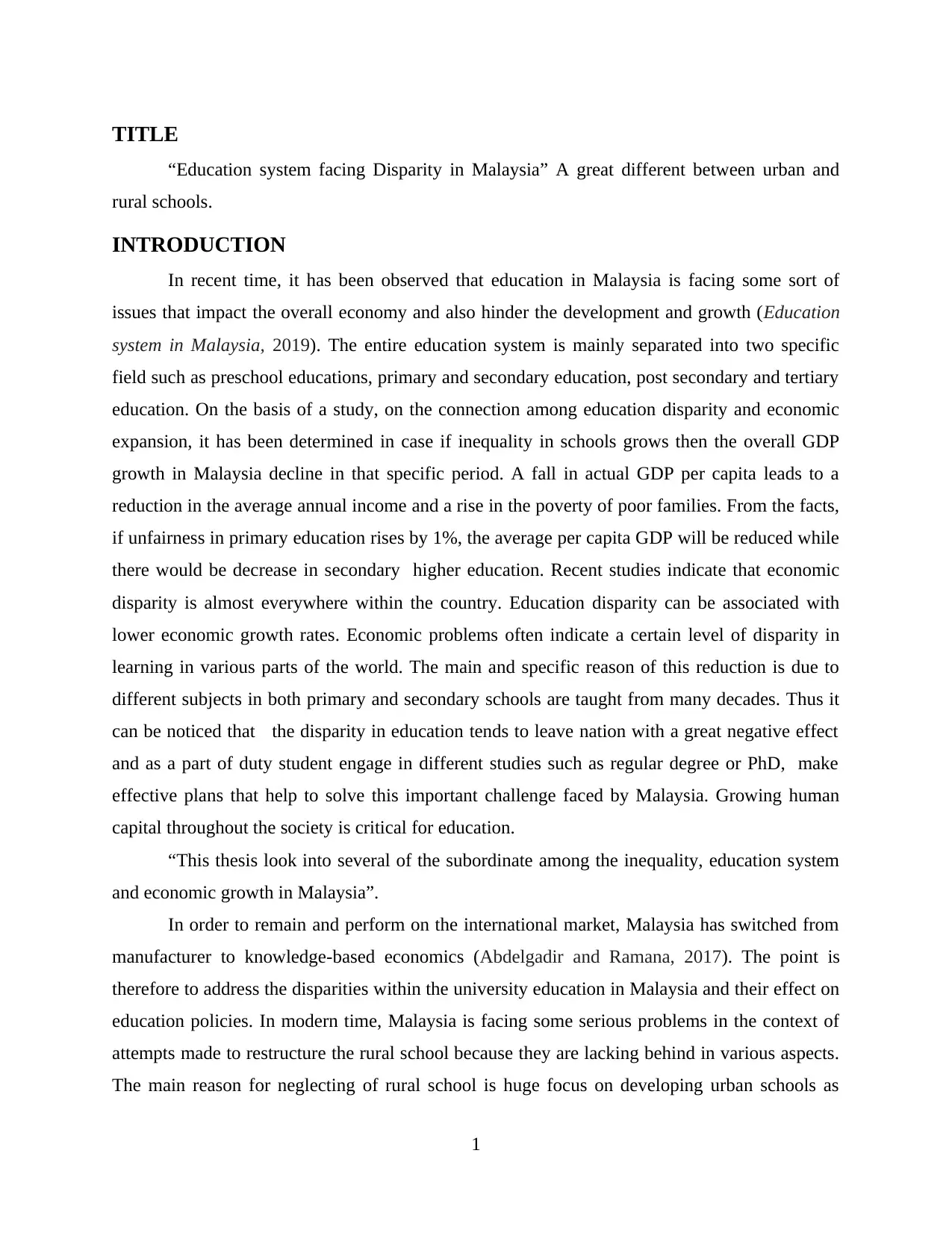
TITLE
“Education system facing Disparity in Malaysia” A great different between urban and
rural schools.
INTRODUCTION
In recent time, it has been observed that education in Malaysia is facing some sort of
issues that impact the overall economy and also hinder the development and growth (Education
system in Malaysia, 2019). The entire education system is mainly separated into two specific
field such as preschool educations, primary and secondary education, post secondary and tertiary
education. On the basis of a study, on the connection among education disparity and economic
expansion, it has been determined in case if inequality in schools grows then the overall GDP
growth in Malaysia decline in that specific period. A fall in actual GDP per capita leads to a
reduction in the average annual income and a rise in the poverty of poor families. From the facts,
if unfairness in primary education rises by 1%, the average per capita GDP will be reduced while
there would be decrease in secondary higher education. Recent studies indicate that economic
disparity is almost everywhere within the country. Education disparity can be associated with
lower economic growth rates. Economic problems often indicate a certain level of disparity in
learning in various parts of the world. The main and specific reason of this reduction is due to
different subjects in both primary and secondary schools are taught from many decades. Thus it
can be noticed that the disparity in education tends to leave nation with a great negative effect
and as a part of duty student engage in different studies such as regular degree or PhD, make
effective plans that help to solve this important challenge faced by Malaysia. Growing human
capital throughout the society is critical for education.
“This thesis look into several of the subordinate among the inequality, education system
and economic growth in Malaysia”.
In order to remain and perform on the international market, Malaysia has switched from
manufacturer to knowledge-based economics (Abdelgadir and Ramana, 2017). The point is
therefore to address the disparities within the university education in Malaysia and their effect on
education policies. In modern time, Malaysia is facing some serious problems in the context of
attempts made to restructure the rural school because they are lacking behind in various aspects.
The main reason for neglecting of rural school is huge focus on developing urban schools as
1
“Education system facing Disparity in Malaysia” A great different between urban and
rural schools.
INTRODUCTION
In recent time, it has been observed that education in Malaysia is facing some sort of
issues that impact the overall economy and also hinder the development and growth (Education
system in Malaysia, 2019). The entire education system is mainly separated into two specific
field such as preschool educations, primary and secondary education, post secondary and tertiary
education. On the basis of a study, on the connection among education disparity and economic
expansion, it has been determined in case if inequality in schools grows then the overall GDP
growth in Malaysia decline in that specific period. A fall in actual GDP per capita leads to a
reduction in the average annual income and a rise in the poverty of poor families. From the facts,
if unfairness in primary education rises by 1%, the average per capita GDP will be reduced while
there would be decrease in secondary higher education. Recent studies indicate that economic
disparity is almost everywhere within the country. Education disparity can be associated with
lower economic growth rates. Economic problems often indicate a certain level of disparity in
learning in various parts of the world. The main and specific reason of this reduction is due to
different subjects in both primary and secondary schools are taught from many decades. Thus it
can be noticed that the disparity in education tends to leave nation with a great negative effect
and as a part of duty student engage in different studies such as regular degree or PhD, make
effective plans that help to solve this important challenge faced by Malaysia. Growing human
capital throughout the society is critical for education.
“This thesis look into several of the subordinate among the inequality, education system
and economic growth in Malaysia”.
In order to remain and perform on the international market, Malaysia has switched from
manufacturer to knowledge-based economics (Abdelgadir and Ramana, 2017). The point is
therefore to address the disparities within the university education in Malaysia and their effect on
education policies. In modern time, Malaysia is facing some serious problems in the context of
attempts made to restructure the rural school because they are lacking behind in various aspects.
The main reason for neglecting of rural school is huge focus on developing urban schools as
1
⊘ This is a preview!⊘
Do you want full access?
Subscribe today to unlock all pages.

Trusted by 1+ million students worldwide

Malay government think that urban school would deliver better results for developing economy
in future time. Rural schools play an important role in assisting a country to educate its citizens
but at the same time educational disparity varies from weak governmental policies, capitalist
economy and terrible education system management (Bohn, 2018). However, in reality, the
Government's reform agenda often pays less attention. The ongoing situation in rural school
within Malaysia is not as per the latest trends and have been struggling to give better education
to rural people. This because the infrastructure facilities are missing, qualified and professional
teacher are not there to give better education etc. On the other side basic daily needs such as mid
day meal, stationery and proper utilities facilities are not properly provided within rural school.
For example, some of the rural school are located within the region which can only be reached
by specific mean of transport such as water transportation vehicles are used to reach the school
situated in Sarawak state. This condition impacts the process of college redevelopment and
restructure. However, the exact circumstance is never yet established and extensive research
needs to be done to study the performance of educational provision and facilities in schools
located in rural areas (Candea and Trimaille, 2015).
The further schooling system in Malaysia is divided into different formats such as
preschool education and primary schools. The concept of primary school states that when an
infant actually starts pre-school education, there are no set criteria but most of the children
should start at the age of 3. School education in the nursery can start sooner, from 3-6. Pre-
school training usually takes 2 years before going to elementary school at 7 years of age. There
are no formal early childhood syllabus apart from a formal obligation for educators and directors
that gives them proper training and certify that they can run a pre-school. The curriculum covers
children's education, methods for instruction as well as other relevant child care and education
programs. Training for kindergarten is compulsory because Malaysian governance wants to
increase the level of education at every level by educating young student the right age so they
can develop future learning and writing skills. Primary school are the schooling that are
primarily presented by private, but is normally run by governmental or minority groups. Thus, it
is stated that Preschool education is primary as almost every primary school a connected section
of pre school for small children in order to make them learn the essential of life and future
education (Canepari and Sharma, 2016). Preschool enrolment is not standardized while in most
2
in future time. Rural schools play an important role in assisting a country to educate its citizens
but at the same time educational disparity varies from weak governmental policies, capitalist
economy and terrible education system management (Bohn, 2018). However, in reality, the
Government's reform agenda often pays less attention. The ongoing situation in rural school
within Malaysia is not as per the latest trends and have been struggling to give better education
to rural people. This because the infrastructure facilities are missing, qualified and professional
teacher are not there to give better education etc. On the other side basic daily needs such as mid
day meal, stationery and proper utilities facilities are not properly provided within rural school.
For example, some of the rural school are located within the region which can only be reached
by specific mean of transport such as water transportation vehicles are used to reach the school
situated in Sarawak state. This condition impacts the process of college redevelopment and
restructure. However, the exact circumstance is never yet established and extensive research
needs to be done to study the performance of educational provision and facilities in schools
located in rural areas (Candea and Trimaille, 2015).
The further schooling system in Malaysia is divided into different formats such as
preschool education and primary schools. The concept of primary school states that when an
infant actually starts pre-school education, there are no set criteria but most of the children
should start at the age of 3. School education in the nursery can start sooner, from 3-6. Pre-
school training usually takes 2 years before going to elementary school at 7 years of age. There
are no formal early childhood syllabus apart from a formal obligation for educators and directors
that gives them proper training and certify that they can run a pre-school. The curriculum covers
children's education, methods for instruction as well as other relevant child care and education
programs. Training for kindergarten is compulsory because Malaysian governance wants to
increase the level of education at every level by educating young student the right age so they
can develop future learning and writing skills. Primary school are the schooling that are
primarily presented by private, but is normally run by governmental or minority groups. Thus, it
is stated that Preschool education is primary as almost every primary school a connected section
of pre school for small children in order to make them learn the essential of life and future
education (Canepari and Sharma, 2016). Preschool enrolment is not standardized while in most
2
Paraphrase This Document
Need a fresh take? Get an instant paraphrase of this document with our AI Paraphraser
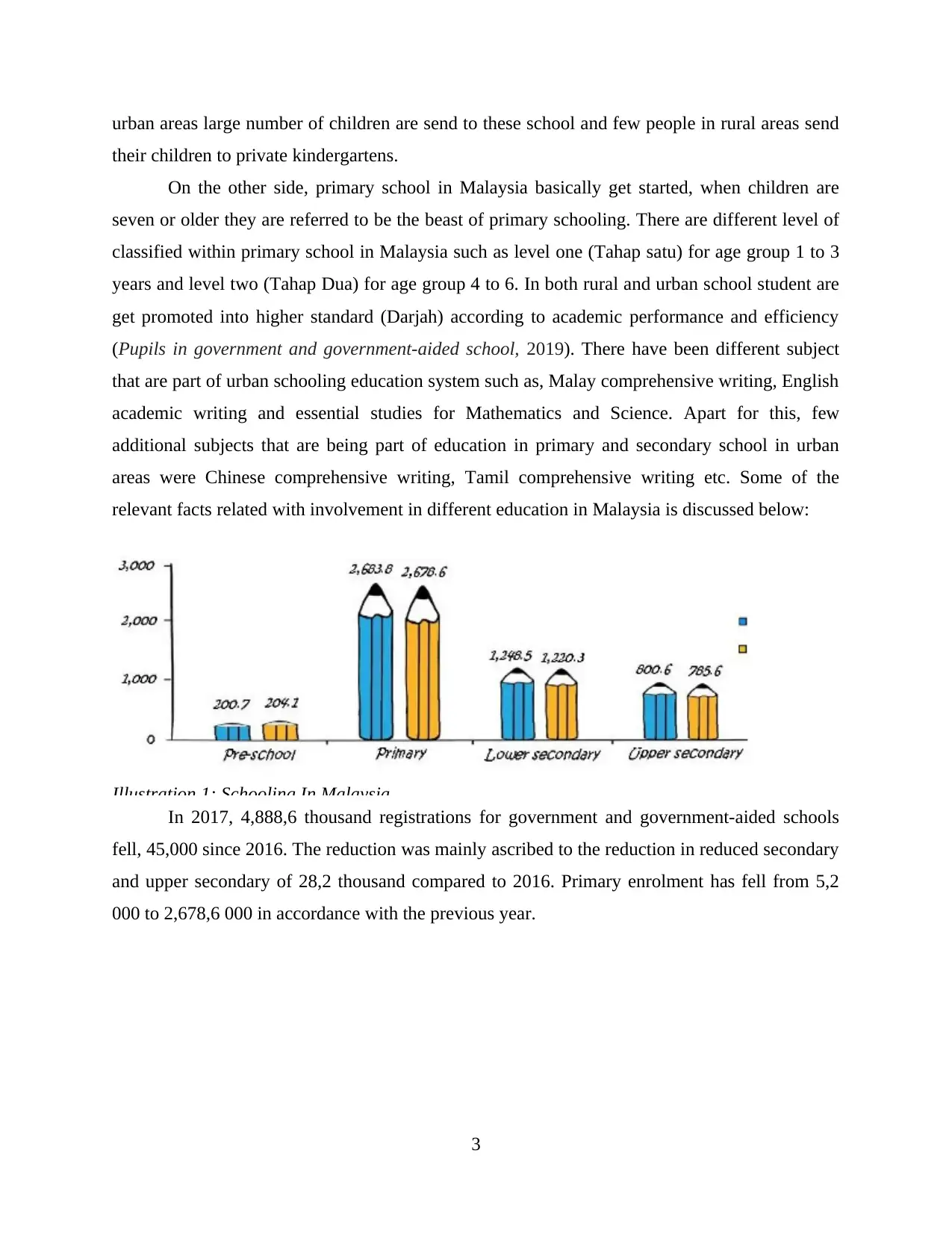
urban areas large number of children are send to these school and few people in rural areas send
their children to private kindergartens.
On the other side, primary school in Malaysia basically get started, when children are
seven or older they are referred to be the beast of primary schooling. There are different level of
classified within primary school in Malaysia such as level one (Tahap satu) for age group 1 to 3
years and level two (Tahap Dua) for age group 4 to 6. In both rural and urban school student are
get promoted into higher standard (Darjah) according to academic performance and efficiency
(Pupils in government and government-aided school, 2019). There have been different subject
that are part of urban schooling education system such as, Malay comprehensive writing, English
academic writing and essential studies for Mathematics and Science. Apart for this, few
additional subjects that are being part of education in primary and secondary school in urban
areas were Chinese comprehensive writing, Tamil comprehensive writing etc. Some of the
relevant facts related with involvement in different education in Malaysia is discussed below:
Illustration 1: Schooling In Malaysia
In 2017, 4,888,6 thousand registrations for government and government-aided schools
fell, 45,000 since 2016. The reduction was mainly ascribed to the reduction in reduced secondary
and upper secondary of 28,2 thousand compared to 2016. Primary enrolment has fell from 5,2
000 to 2,678,6 000 in accordance with the previous year.
3
their children to private kindergartens.
On the other side, primary school in Malaysia basically get started, when children are
seven or older they are referred to be the beast of primary schooling. There are different level of
classified within primary school in Malaysia such as level one (Tahap satu) for age group 1 to 3
years and level two (Tahap Dua) for age group 4 to 6. In both rural and urban school student are
get promoted into higher standard (Darjah) according to academic performance and efficiency
(Pupils in government and government-aided school, 2019). There have been different subject
that are part of urban schooling education system such as, Malay comprehensive writing, English
academic writing and essential studies for Mathematics and Science. Apart for this, few
additional subjects that are being part of education in primary and secondary school in urban
areas were Chinese comprehensive writing, Tamil comprehensive writing etc. Some of the
relevant facts related with involvement in different education in Malaysia is discussed below:
Illustration 1: Schooling In Malaysia
In 2017, 4,888,6 thousand registrations for government and government-aided schools
fell, 45,000 since 2016. The reduction was mainly ascribed to the reduction in reduced secondary
and upper secondary of 28,2 thousand compared to 2016. Primary enrolment has fell from 5,2
000 to 2,678,6 000 in accordance with the previous year.
3
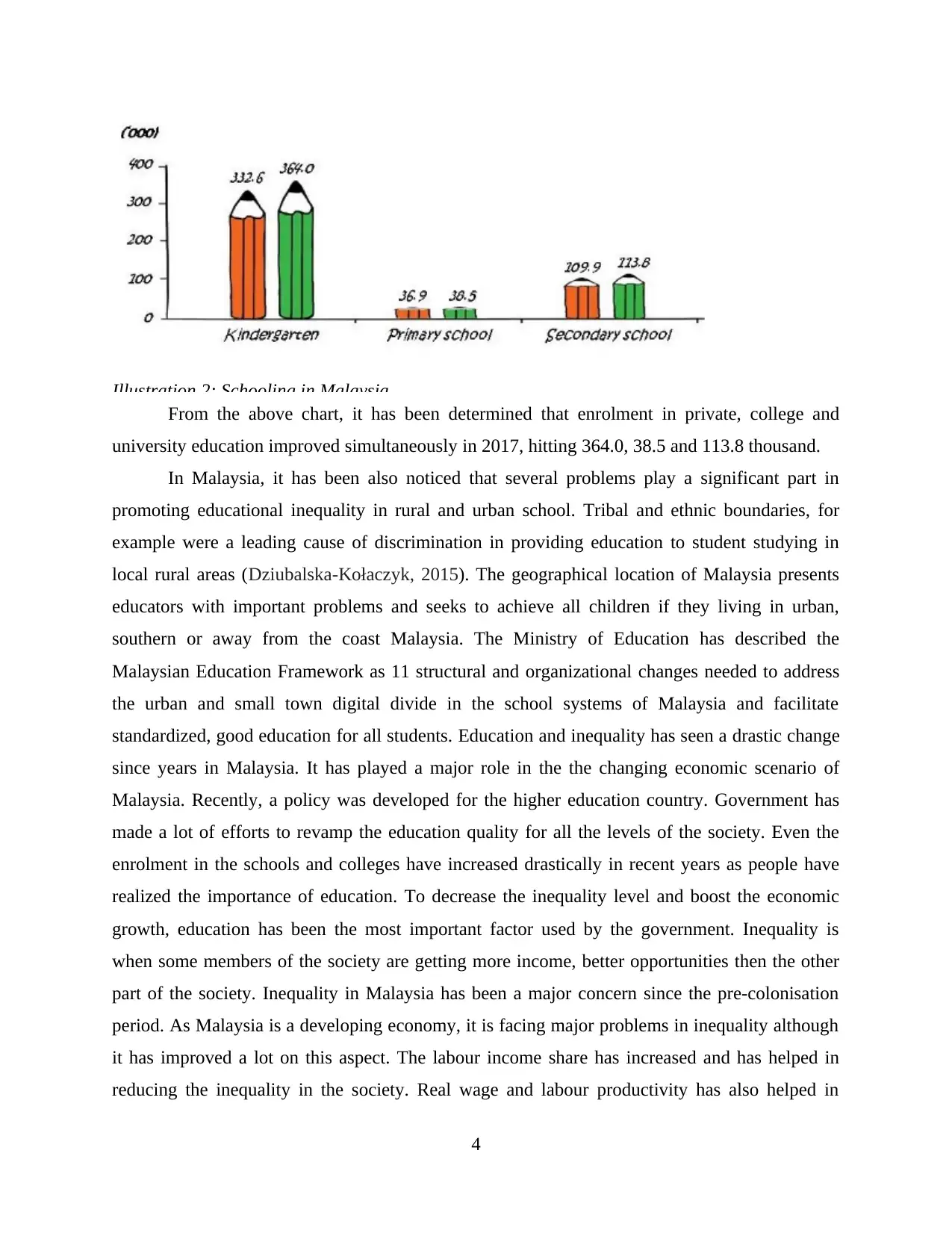
Illustration 2: Schooling in Malaysia
From the above chart, it has been determined that enrolment in private, college and
university education improved simultaneously in 2017, hitting 364.0, 38.5 and 113.8 thousand.
In Malaysia, it has been also noticed that several problems play a significant part in
promoting educational inequality in rural and urban school. Tribal and ethnic boundaries, for
example were a leading cause of discrimination in providing education to student studying in
local rural areas (Dziubalska-Kołaczyk, 2015). The geographical location of Malaysia presents
educators with important problems and seeks to achieve all children if they living in urban,
southern or away from the coast Malaysia. The Ministry of Education has described the
Malaysian Education Framework as 11 structural and organizational changes needed to address
the urban and small town digital divide in the school systems of Malaysia and facilitate
standardized, good education for all students. Education and inequality has seen a drastic change
since years in Malaysia. It has played a major role in the the changing economic scenario of
Malaysia. Recently, a policy was developed for the higher education country. Government has
made a lot of efforts to revamp the education quality for all the levels of the society. Even the
enrolment in the schools and colleges have increased drastically in recent years as people have
realized the importance of education. To decrease the inequality level and boost the economic
growth, education has been the most important factor used by the government. Inequality is
when some members of the society are getting more income, better opportunities then the other
part of the society. Inequality in Malaysia has been a major concern since the pre-colonisation
period. As Malaysia is a developing economy, it is facing major problems in inequality although
it has improved a lot on this aspect. The labour income share has increased and has helped in
reducing the inequality in the society. Real wage and labour productivity has also helped in
4
From the above chart, it has been determined that enrolment in private, college and
university education improved simultaneously in 2017, hitting 364.0, 38.5 and 113.8 thousand.
In Malaysia, it has been also noticed that several problems play a significant part in
promoting educational inequality in rural and urban school. Tribal and ethnic boundaries, for
example were a leading cause of discrimination in providing education to student studying in
local rural areas (Dziubalska-Kołaczyk, 2015). The geographical location of Malaysia presents
educators with important problems and seeks to achieve all children if they living in urban,
southern or away from the coast Malaysia. The Ministry of Education has described the
Malaysian Education Framework as 11 structural and organizational changes needed to address
the urban and small town digital divide in the school systems of Malaysia and facilitate
standardized, good education for all students. Education and inequality has seen a drastic change
since years in Malaysia. It has played a major role in the the changing economic scenario of
Malaysia. Recently, a policy was developed for the higher education country. Government has
made a lot of efforts to revamp the education quality for all the levels of the society. Even the
enrolment in the schools and colleges have increased drastically in recent years as people have
realized the importance of education. To decrease the inequality level and boost the economic
growth, education has been the most important factor used by the government. Inequality is
when some members of the society are getting more income, better opportunities then the other
part of the society. Inequality in Malaysia has been a major concern since the pre-colonisation
period. As Malaysia is a developing economy, it is facing major problems in inequality although
it has improved a lot on this aspect. The labour income share has increased and has helped in
reducing the inequality in the society. Real wage and labour productivity has also helped in
4
⊘ This is a preview!⊘
Do you want full access?
Subscribe today to unlock all pages.

Trusted by 1+ million students worldwide
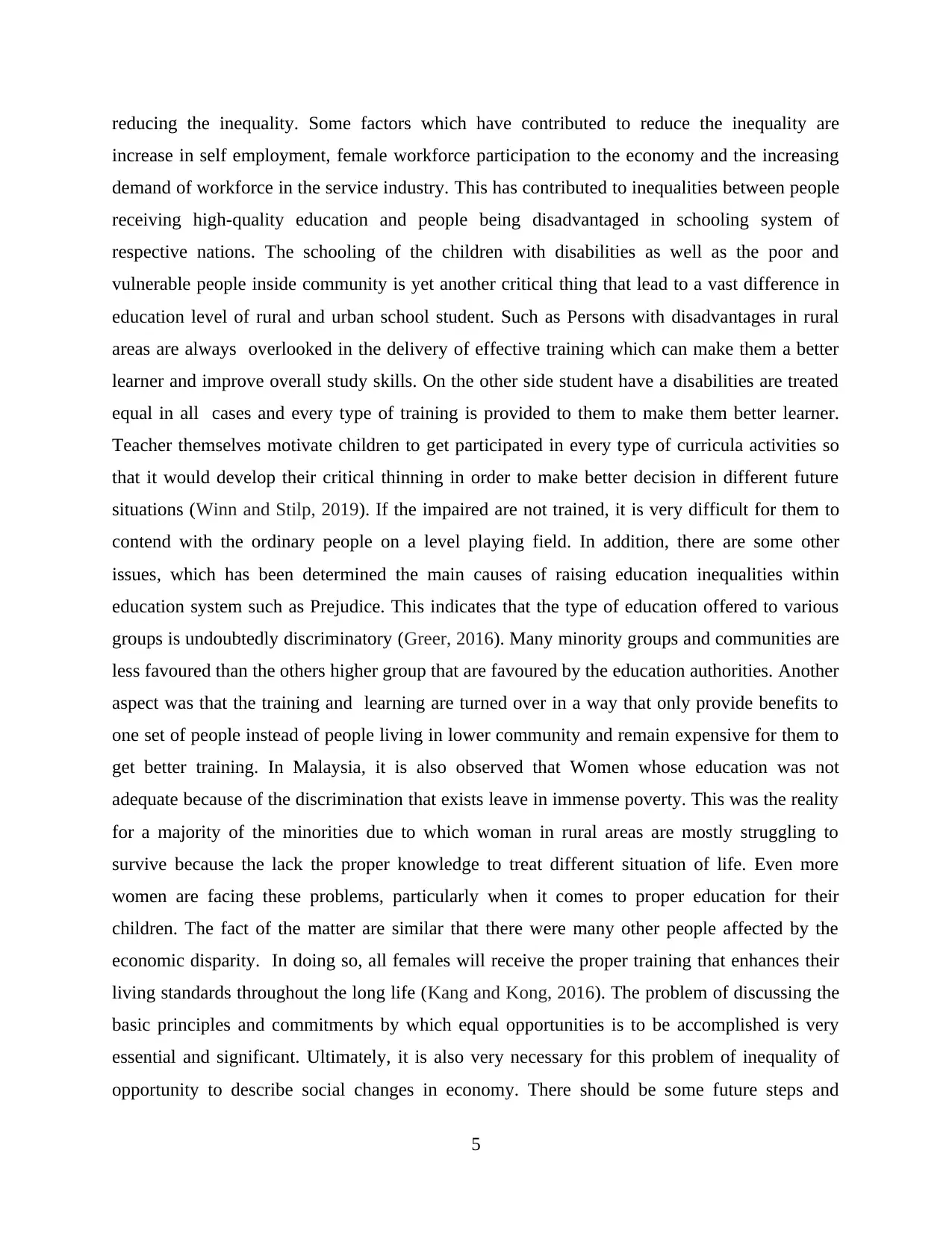
reducing the inequality. Some factors which have contributed to reduce the inequality are
increase in self employment, female workforce participation to the economy and the increasing
demand of workforce in the service industry. This has contributed to inequalities between people
receiving high-quality education and people being disadvantaged in schooling system of
respective nations. The schooling of the children with disabilities as well as the poor and
vulnerable people inside community is yet another critical thing that lead to a vast difference in
education level of rural and urban school student. Such as Persons with disadvantages in rural
areas are always overlooked in the delivery of effective training which can make them a better
learner and improve overall study skills. On the other side student have a disabilities are treated
equal in all cases and every type of training is provided to them to make them better learner.
Teacher themselves motivate children to get participated in every type of curricula activities so
that it would develop their critical thinning in order to make better decision in different future
situations (Winn and Stilp, 2019). If the impaired are not trained, it is very difficult for them to
contend with the ordinary people on a level playing field. In addition, there are some other
issues, which has been determined the main causes of raising education inequalities within
education system such as Prejudice. This indicates that the type of education offered to various
groups is undoubtedly discriminatory (Greer, 2016). Many minority groups and communities are
less favoured than the others higher group that are favoured by the education authorities. Another
aspect was that the training and learning are turned over in a way that only provide benefits to
one set of people instead of people living in lower community and remain expensive for them to
get better training. In Malaysia, it is also observed that Women whose education was not
adequate because of the discrimination that exists leave in immense poverty. This was the reality
for a majority of the minorities due to which woman in rural areas are mostly struggling to
survive because the lack the proper knowledge to treat different situation of life. Even more
women are facing these problems, particularly when it comes to proper education for their
children. The fact of the matter are similar that there were many other people affected by the
economic disparity. In doing so, all females will receive the proper training that enhances their
living standards throughout the long life (Kang and Kong, 2016). The problem of discussing the
basic principles and commitments by which equal opportunities is to be accomplished is very
essential and significant. Ultimately, it is also very necessary for this problem of inequality of
opportunity to describe social changes in economy. There should be some future steps and
5
increase in self employment, female workforce participation to the economy and the increasing
demand of workforce in the service industry. This has contributed to inequalities between people
receiving high-quality education and people being disadvantaged in schooling system of
respective nations. The schooling of the children with disabilities as well as the poor and
vulnerable people inside community is yet another critical thing that lead to a vast difference in
education level of rural and urban school student. Such as Persons with disadvantages in rural
areas are always overlooked in the delivery of effective training which can make them a better
learner and improve overall study skills. On the other side student have a disabilities are treated
equal in all cases and every type of training is provided to them to make them better learner.
Teacher themselves motivate children to get participated in every type of curricula activities so
that it would develop their critical thinning in order to make better decision in different future
situations (Winn and Stilp, 2019). If the impaired are not trained, it is very difficult for them to
contend with the ordinary people on a level playing field. In addition, there are some other
issues, which has been determined the main causes of raising education inequalities within
education system such as Prejudice. This indicates that the type of education offered to various
groups is undoubtedly discriminatory (Greer, 2016). Many minority groups and communities are
less favoured than the others higher group that are favoured by the education authorities. Another
aspect was that the training and learning are turned over in a way that only provide benefits to
one set of people instead of people living in lower community and remain expensive for them to
get better training. In Malaysia, it is also observed that Women whose education was not
adequate because of the discrimination that exists leave in immense poverty. This was the reality
for a majority of the minorities due to which woman in rural areas are mostly struggling to
survive because the lack the proper knowledge to treat different situation of life. Even more
women are facing these problems, particularly when it comes to proper education for their
children. The fact of the matter are similar that there were many other people affected by the
economic disparity. In doing so, all females will receive the proper training that enhances their
living standards throughout the long life (Kang and Kong, 2016). The problem of discussing the
basic principles and commitments by which equal opportunities is to be accomplished is very
essential and significant. Ultimately, it is also very necessary for this problem of inequality of
opportunity to describe social changes in economy. There should be some future steps and
5
Paraphrase This Document
Need a fresh take? Get an instant paraphrase of this document with our AI Paraphraser
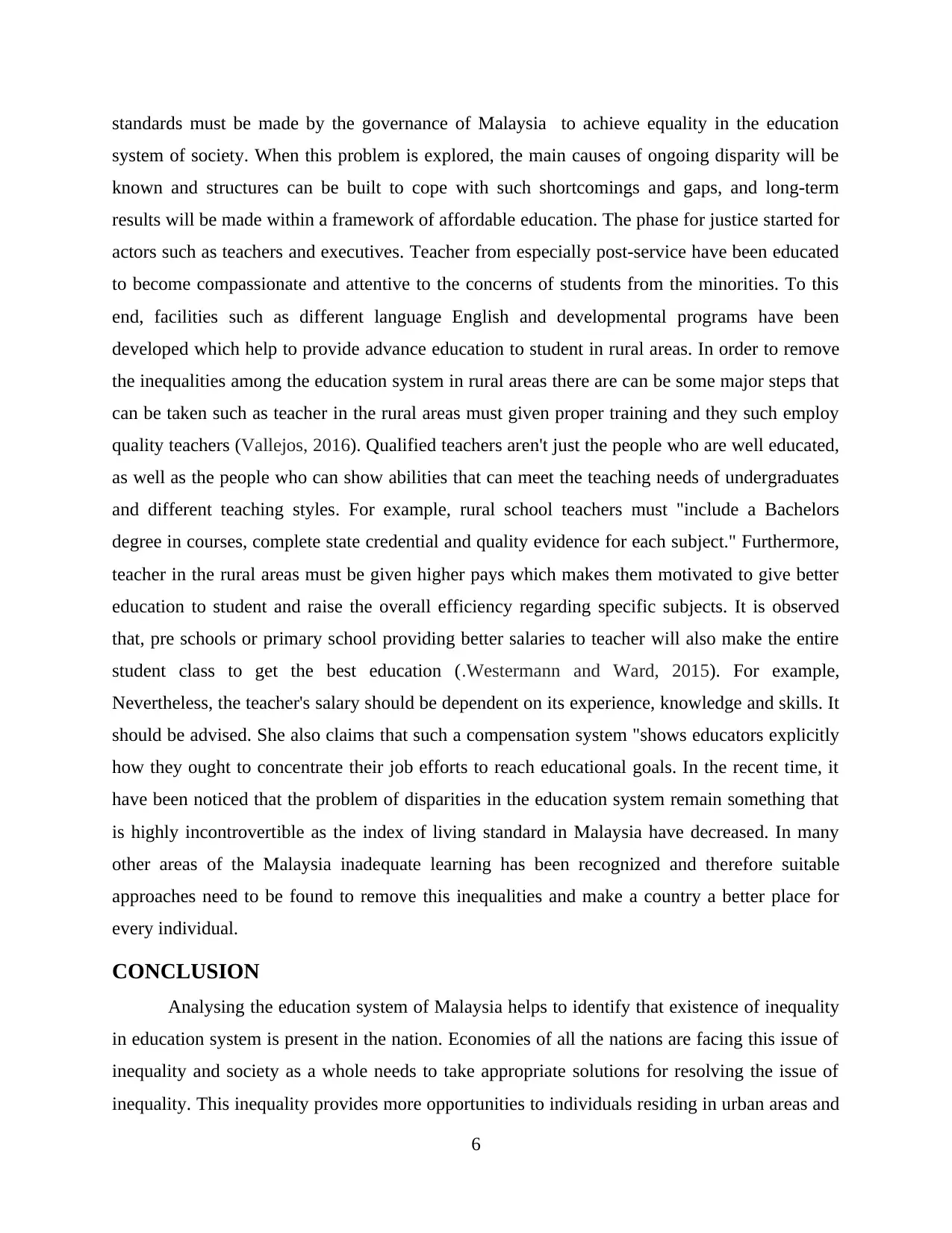
standards must be made by the governance of Malaysia to achieve equality in the education
system of society. When this problem is explored, the main causes of ongoing disparity will be
known and structures can be built to cope with such shortcomings and gaps, and long-term
results will be made within a framework of affordable education. The phase for justice started for
actors such as teachers and executives. Teacher from especially post-service have been educated
to become compassionate and attentive to the concerns of students from the minorities. To this
end, facilities such as different language English and developmental programs have been
developed which help to provide advance education to student in rural areas. In order to remove
the inequalities among the education system in rural areas there are can be some major steps that
can be taken such as teacher in the rural areas must given proper training and they such employ
quality teachers (Vallejos, 2016). Qualified teachers aren't just the people who are well educated,
as well as the people who can show abilities that can meet the teaching needs of undergraduates
and different teaching styles. For example, rural school teachers must "include a Bachelors
degree in courses, complete state credential and quality evidence for each subject." Furthermore,
teacher in the rural areas must be given higher pays which makes them motivated to give better
education to student and raise the overall efficiency regarding specific subjects. It is observed
that, pre schools or primary school providing better salaries to teacher will also make the entire
student class to get the best education (.Westermann and Ward, 2015). For example,
Nevertheless, the teacher's salary should be dependent on its experience, knowledge and skills. It
should be advised. She also claims that such a compensation system "shows educators explicitly
how they ought to concentrate their job efforts to reach educational goals. In the recent time, it
have been noticed that the problem of disparities in the education system remain something that
is highly incontrovertible as the index of living standard in Malaysia have decreased. In many
other areas of the Malaysia inadequate learning has been recognized and therefore suitable
approaches need to be found to remove this inequalities and make a country a better place for
every individual.
CONCLUSION
Analysing the education system of Malaysia helps to identify that existence of inequality
in education system is present in the nation. Economies of all the nations are facing this issue of
inequality and society as a whole needs to take appropriate solutions for resolving the issue of
inequality. This inequality provides more opportunities to individuals residing in urban areas and
6
system of society. When this problem is explored, the main causes of ongoing disparity will be
known and structures can be built to cope with such shortcomings and gaps, and long-term
results will be made within a framework of affordable education. The phase for justice started for
actors such as teachers and executives. Teacher from especially post-service have been educated
to become compassionate and attentive to the concerns of students from the minorities. To this
end, facilities such as different language English and developmental programs have been
developed which help to provide advance education to student in rural areas. In order to remove
the inequalities among the education system in rural areas there are can be some major steps that
can be taken such as teacher in the rural areas must given proper training and they such employ
quality teachers (Vallejos, 2016). Qualified teachers aren't just the people who are well educated,
as well as the people who can show abilities that can meet the teaching needs of undergraduates
and different teaching styles. For example, rural school teachers must "include a Bachelors
degree in courses, complete state credential and quality evidence for each subject." Furthermore,
teacher in the rural areas must be given higher pays which makes them motivated to give better
education to student and raise the overall efficiency regarding specific subjects. It is observed
that, pre schools or primary school providing better salaries to teacher will also make the entire
student class to get the best education (.Westermann and Ward, 2015). For example,
Nevertheless, the teacher's salary should be dependent on its experience, knowledge and skills. It
should be advised. She also claims that such a compensation system "shows educators explicitly
how they ought to concentrate their job efforts to reach educational goals. In the recent time, it
have been noticed that the problem of disparities in the education system remain something that
is highly incontrovertible as the index of living standard in Malaysia have decreased. In many
other areas of the Malaysia inadequate learning has been recognized and therefore suitable
approaches need to be found to remove this inequalities and make a country a better place for
every individual.
CONCLUSION
Analysing the education system of Malaysia helps to identify that existence of inequality
in education system is present in the nation. Economies of all the nations are facing this issue of
inequality and society as a whole needs to take appropriate solutions for resolving the issue of
inequality. This inequality provides more opportunities to individuals residing in urban areas and
6

where gender inequality exists more opportunities are provided to preferred gender. Educational
inequalities brings various other issues that hinders existence of economy of a nation. As income
disparities and standard of living are the two economic terms that are effected through level of
education existed in the country. Government of Malaysia needs to consider educational
inequalities as one of the major issue and make all the required efforts to bring equality in
educational sector of rural and urban area.
7
inequalities brings various other issues that hinders existence of economy of a nation. As income
disparities and standard of living are the two economic terms that are effected through level of
education existed in the country. Government of Malaysia needs to consider educational
inequalities as one of the major issue and make all the required efforts to bring equality in
educational sector of rural and urban area.
7
⊘ This is a preview!⊘
Do you want full access?
Subscribe today to unlock all pages.

Trusted by 1+ million students worldwide
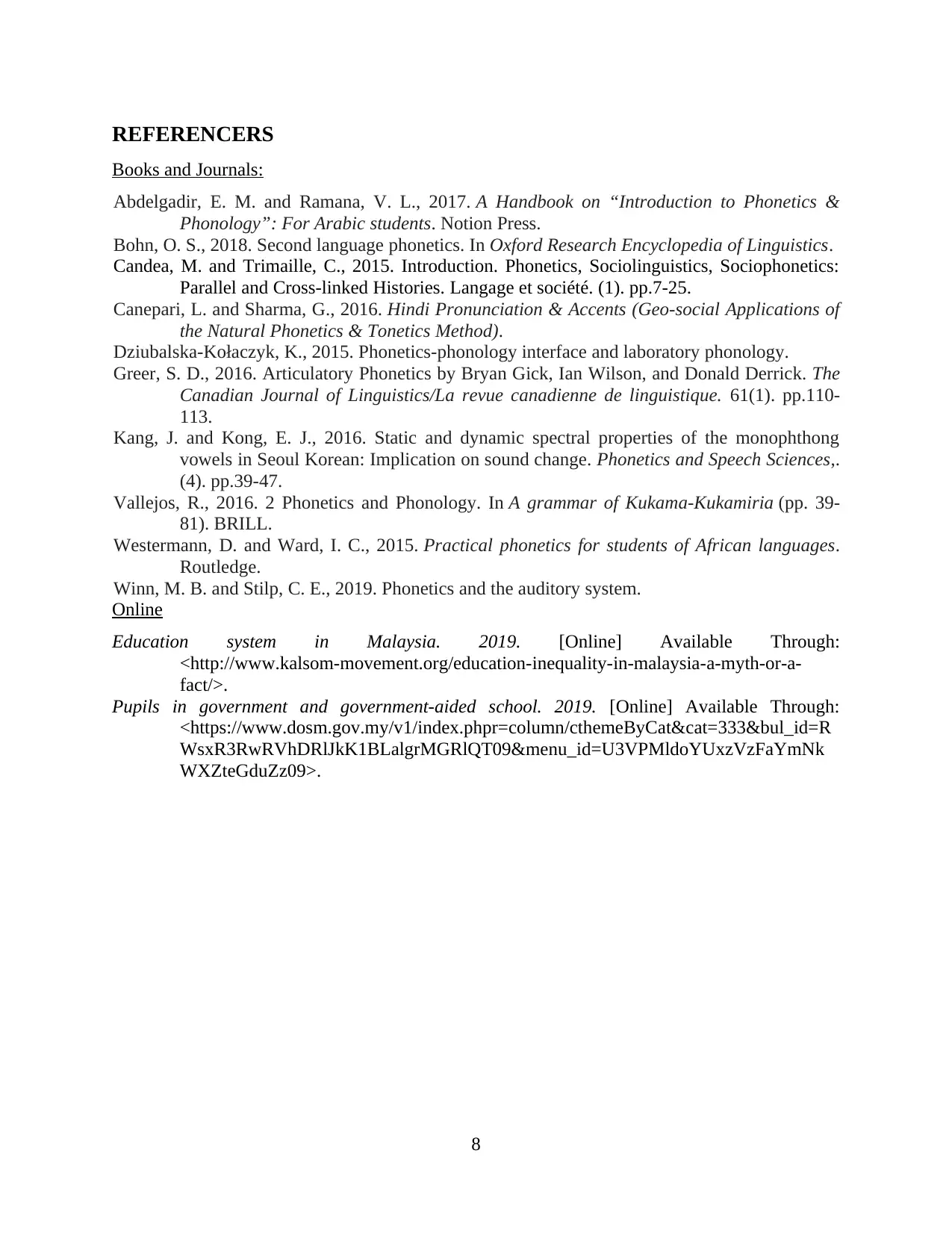
REFERENCERS
Books and Journals:
Abdelgadir, E. M. and Ramana, V. L., 2017. A Handbook on “Introduction to Phonetics &
Phonology”: For Arabic students. Notion Press.
Bohn, O. S., 2018. Second language phonetics. In Oxford Research Encyclopedia of Linguistics.
Candea, M. and Trimaille, C., 2015. Introduction. Phonetics, Sociolinguistics, Sociophonetics:
Parallel and Cross-linked Histories. Langage et société. (1). pp.7-25.
Canepari, L. and Sharma, G., 2016. Hindi Pronunciation & Accents (Geo-social Applications of
the Natural Phonetics & Tonetics Method).
Dziubalska-Kołaczyk, K., 2015. Phonetics-phonology interface and laboratory phonology.
Greer, S. D., 2016. Articulatory Phonetics by Bryan Gick, Ian Wilson, and Donald Derrick. The
Canadian Journal of Linguistics/La revue canadienne de linguistique. 61(1). pp.110-
113.
Kang, J. and Kong, E. J., 2016. Static and dynamic spectral properties of the monophthong
vowels in Seoul Korean: Implication on sound change. Phonetics and Speech Sciences,.
(4). pp.39-47.
Vallejos, R., 2016. 2 Phonetics and Phonology. In A grammar of Kukama-Kukamiria (pp. 39-
81). BRILL.
Westermann, D. and Ward, I. C., 2015. Practical phonetics for students of African languages.
Routledge.
Winn, M. B. and Stilp, C. E., 2019. Phonetics and the auditory system.
Online
Education system in Malaysia. 2019. [Online] Available Through:
<http://www.kalsom-movement.org/education-inequality-in-malaysia-a-myth-or-a-
fact/>.
Pupils in government and government-aided school. 2019. [Online] Available Through:
<https://www.dosm.gov.my/v1/index.phpr=column/cthemeByCat&cat=333&bul_id=R
WsxR3RwRVhDRlJkK1BLalgrMGRlQT09&menu_id=U3VPMldoYUxzVzFaYmNk
WXZteGduZz09>.
8
Books and Journals:
Abdelgadir, E. M. and Ramana, V. L., 2017. A Handbook on “Introduction to Phonetics &
Phonology”: For Arabic students. Notion Press.
Bohn, O. S., 2018. Second language phonetics. In Oxford Research Encyclopedia of Linguistics.
Candea, M. and Trimaille, C., 2015. Introduction. Phonetics, Sociolinguistics, Sociophonetics:
Parallel and Cross-linked Histories. Langage et société. (1). pp.7-25.
Canepari, L. and Sharma, G., 2016. Hindi Pronunciation & Accents (Geo-social Applications of
the Natural Phonetics & Tonetics Method).
Dziubalska-Kołaczyk, K., 2015. Phonetics-phonology interface and laboratory phonology.
Greer, S. D., 2016. Articulatory Phonetics by Bryan Gick, Ian Wilson, and Donald Derrick. The
Canadian Journal of Linguistics/La revue canadienne de linguistique. 61(1). pp.110-
113.
Kang, J. and Kong, E. J., 2016. Static and dynamic spectral properties of the monophthong
vowels in Seoul Korean: Implication on sound change. Phonetics and Speech Sciences,.
(4). pp.39-47.
Vallejos, R., 2016. 2 Phonetics and Phonology. In A grammar of Kukama-Kukamiria (pp. 39-
81). BRILL.
Westermann, D. and Ward, I. C., 2015. Practical phonetics for students of African languages.
Routledge.
Winn, M. B. and Stilp, C. E., 2019. Phonetics and the auditory system.
Online
Education system in Malaysia. 2019. [Online] Available Through:
<http://www.kalsom-movement.org/education-inequality-in-malaysia-a-myth-or-a-
fact/>.
Pupils in government and government-aided school. 2019. [Online] Available Through:
<https://www.dosm.gov.my/v1/index.phpr=column/cthemeByCat&cat=333&bul_id=R
WsxR3RwRVhDRlJkK1BLalgrMGRlQT09&menu_id=U3VPMldoYUxzVzFaYmNk
WXZteGduZz09>.
8
1 out of 10
Related Documents
Your All-in-One AI-Powered Toolkit for Academic Success.
+13062052269
info@desklib.com
Available 24*7 on WhatsApp / Email
![[object Object]](/_next/static/media/star-bottom.7253800d.svg)
Unlock your academic potential
Copyright © 2020–2025 A2Z Services. All Rights Reserved. Developed and managed by ZUCOL.




